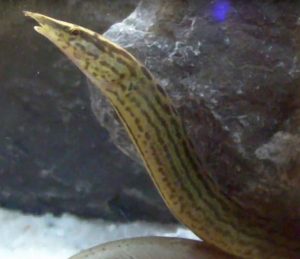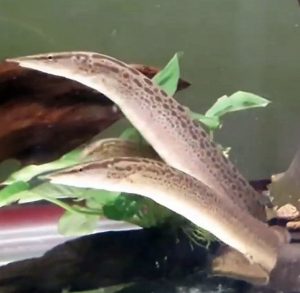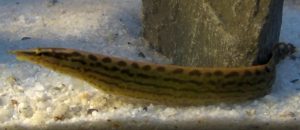The Black Spotted Eel (Mastacembelus dayi) also known to tropical fish keeping enthusiasts as the Polka Dot Eel or Spotted Spiny Eel is found in Asia from the Irrawady and Chindwin river drainages of western Myanmar, and eastern Thailand.
Black Spotted Eels are found in rivers and streams with a lot of moving water, dense vegetation, and sandy or heavily pebbled bottoms.
During the dry season, the Black Spotted Eel migrates into the deeper canals, lakes, and floodplain areas where the water movement is minimal.
Black Spotted Eels are a shy, largely nocturnal species that spends the daylight hours buried in the substrate. They become active at night when they come out to forage on worms, insect larvae, crustaceans, small fish, and occasionally vegetation.
Mastacembelus dayi have an elongated snout with both the dorsal and anal fins extending and joined to the caudal fin.
They can be colored a dark (almost chocolate) tan, to a light brown, and have a series of rather large, dark, irregular spots aligned along the entire length of its body.
The spots along the upper part of the body are normally darker than those below the lateral line, and some of the spots along the lateral line are more elongated than round. The pattern begins from the tip of the mouth and extends to the rear of the eel.
It is almost impossible to sex Black Spotted Eels however, mature females are believed to be more full bodied than the males.
Because the Black Spotted Eel is a large species that can grow to over 20 inches in length, they require a densely planted aquarium of at least 55
gallon capacity with a sandy or fine gravel substrate, a piece of PVC pipe and/or plenty of rocks made into makeshift caves for them to hide among, some driftwood roots, and some floating plants
to diffuse the lighting and afford them a sense of security.
Black Spotted Eels need pristine, well oxygenated water conditions with a decent water flow. Frequent 30% weekly water changes are mandatory for this eel and a canister filter along with an adequately sized powerhead is highly recommended to produce the required conditions.
Like all spiney eels, they tend to be escape artists, so a tight fitting tank cover is highly recommended.
Black Spotted Eels are burrowers and will spend most of the daylight hours buried in the sand. Providing them plenty of hiding places will often get them moving around more.
Mastacembelus dayi get along well in a community tank with larger tank mates, however they need several caves or pieces of PVC pipe in the tank where they can retreat to. They do not get along with others of their own kind, and smaller fish should never be kept with this species. Although It is peaceful with larger tank mates, smaller fish will be regarded as food.
Over time, as Black Spotted Eels become more comfortable in their surroundings, they will recognize their owners and will often take food from their keepers hands.
Although the Black Spotted Eel has never been bred in an aquarium environment, it is presumed that their breeding process is similar to other Spiny Eels.
The courtship lasts for several hours. The pairs will chase each other around in a circle until breeding takes place. The sticky eggs are generally deposited among floating plants and will hatch out in 3 to 4 days. The fry become free swimming in a few more days and can be fed baby brine shrimp. Because of their susceptibility to fungal infections, the fry are difficult to raise and anti fungal water treatments or Indian Almond Leaves are often used to combat the problem.
In their natural habitat, the Black Spotted Eel is omnivorous. They are opportunistic nocturnal feeders that will eat benthic insect larvae, worms, aquatic invertebrates, and some plant matter.
In an aquarium environment, they will eat live, and most frozen foods such as small fish, shrimp, bloodworms, and earthworms. They can be trained to eat freeze dried bloodworms or brine shrimp but it should not be their primary diet.
Feed them only a couple of times a week, and then only after the lights in the tank have been turned off.
Black Spotted Eels, aka Polka Dot Eel or Spotted Spiny Eel, are commonly available online and at specialty tropical fish shops at reasonable prices.
Minimum Tank Size: 55 gallons
Care Level: Moderate
Temperament: Shy, Peaceful
Aquarium Hardiness: Moderately Hardy
Water Conditions: 74-82° F, 6-25 dGH, pH 6.0-8.0
Max. Size: 20″
Color Form: Brown, Tan
Diet: Omnivore
Compatibility: Community
Origin: Western Myanmar, Eastern Thailand
Family: Mastacembelidae
Lifespan: 8-18 years
Aquarist Experience Level: Intermediate






I have what I believe to be a black spotted spiny eel. I’ve had him for 5 years. He’s about 2 feet long. He lives in a 120 gallon tank. I have a Fluval FX-6 canister filter. I use 6 bags of carbon and the rest is mechanical filtration and a 100 gallon Aqueon filter that sits on top of the tank with 2 carbon inserts. The tank also has 2 power heads hooked up to a under gravel system and a large air stone and a wave maker that shoots water right down where he hangs out so I believe the water has more then enough oxygen for him. His tank mates are 2 full grown tin foil barbs, one green terror and 4 plecostomus. He’s eaten 2 tiny red worms in the last 6 weeks. He refuses to eat and has heavy breathing all the time (panting). I’ve tried cooler water, warmer water, aquarium salt and API general cure with no good results. I don’t know what else to try. Now that I think about it in the years past he has had times of heavy breathing but not continuously. I never figured it to be a bad thing because he was always eating. But now he doesn’t eat and the breathing is very heavy. On the outside he has no scratches or scrapes or puncture wounds and there’s no signs of ick or any type of white fungus anywhere. His outer body looks normal. I checked the water with a test kit and everything seemed to be fine. I also took a sample to my local pet store and had the water checked and that test also came back normal. No problem with the water. If there’s anything you can suggest it would be greatly appreciated. He’s a beautiful eel and I don’t want to lose him. I sent some pictures and a small video with this email.
pH – 7.6
Nitrite – 0
Nitrate – 80 – To me it looked close between 40 and 80 but the girl at the pet store said 80 so that’s what I’m going with.
Ammonia – 0
The tank has been set up for 5 years. Size 120 gallons. Last water change 1 week ago. Water source tap water. I do use water conditioner when doing water changes. Regular water changes every 4 weeks. Water and filter change every 6 weeks. Water parameters were checked today August 24th. I used a liquid test kit. Temperature 82. Tank mates 2 adult tin foil barbs, 4 adult plecostomus and 1 adult green terror female small. Like I said in my original email the eel has always had periods of heavy breathing but not continuously like this and has never refused food. That’s all I got for you. Please help.